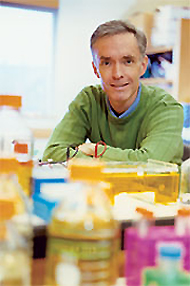Breakthrough Scientist Gets Big Donor Backing
Jim Collins becomes BU’s first Howard Hughes Medical Institute investigator

Jim Collins is used to breaking boundaries. The College of Engineering professor of biomedical engineering started off studying physics, moved to medical engineering as a graduate student, and just a few years ago made the jump to molecular biology, where he’s helped pioneer the new fields of systems biology and synthetic biology.
Along the way, Collins developed the first genetic “toggle switch,” a bioengineered circuit that works like a light switch in a cell, prompting it to start or stop an immune response or the production of certain proteins when stimulated by a drug or a toxin. And he and fellow researchers at his Applied BioDynamics Laboratory have been reverse engineering the cellular and genetic networks of bacteria.
Last week, Collins achieved another breakthrough, becoming the first Boston University researcher to be named a Howard Hughes Medical Institute (HHMI) investigator, an honor that provides him with long-term funding for the type of bold research projects that government funding agencies are increasingly hesitant to support.
Collins was one of 56 new investigators chosen this year from more than 1,000 applicants nationwide. Rather than receiving a traditional grant, he will now technically become an employee of HHMI, a nonprofit supporter of biomedical research founded by Howard Hughes, the late aviator, engineer, and film producer. The institute will provide him with a salary and money for postdoctoral researchers and other lab assistance, along with equipment and supplies, for at least five years (subject to renewal). At the same time, Collins will maintain his faculty position at BU and continue as codirector of the Center for BioDynamics.
The exact amount of money heading Collins’ way is uncertain. “We will be working out a budget in the next few weeks,” he says. But HHMI is committing more than $600 million to fund this year’s crop of investigators over the next five years. It will be money well spent, according to Andrei Ruckenstein, a College of Arts and Sciences professor of physics and the University’s associate provost and vice president for research.
“This well-deserved honor represents a significant juncture in Jim’s career and will have a profound impact on his research group, whose work is already having an important impact in a number of areas of biomedical research,” Ruckenstein says.
Indeed, Collins’ inspiration for making discoveries that impact patient care goes back to his childhood, growing up in a family of engineers and having two grandfathers with disabilities (one blind and another debilitated by several strokes).
“I was struck as a kid and a high school student by how little was done for these guys in rehab,” Collins said in a spring 2006 Bostonia profile. His first breakthrough after joining the BU faculty in 1990 was in the area of “whole body systems,” namely balance control. He developed special insoles that sent small vibrations to electrically stimulate the sensory pathways between the feet and the central nervous system of people whose age or medical condition had led to balance problems.
By the late 1990s, Collins began applying his systems approach to molecular and cellular biology. While he had little formal training in those disciplines, the move was supported and encouraged by his colleagues, among them Charles Cantor, an ENG professor of biomedical engineering and a professor of pharmacology at the School of Medicine, who was then chair of Collins’ department, and Charles DeLisi, ENG dean emeritus and Arthur G. B. Metcalf Professor of Science and Engineering. Since then, in addition to cofounding two biotech start-ups, Collins has won a “genius grant” from the MacArthur Foundation, in 2003, and was named one of 50 outstanding leaders in science and technology by Scientific American in 2005. Still, Collins says, the award he’s most proud of is his Metcalf Cup and Prize for Excellence in Teaching, BU’s highest award for teaching, which he received in 2000.
The slogan of the HHMI investigator program is “people, not projects.” Collins says the new funding will support particular areas of research involving systems biology and synthetic biology, including the development of a more effective antibiotic. Using engineered bacteria cell circuitry, he and his lab team aim to “better understand how bacteria respond to existing antibiotics and other stimuli by researching the function of protective and cell-death pathways.”
The lab will also be using synthetic genetic networks to test out “genetic mediators behind the development and progression of different diseases,” with an eye toward using the results to help design new drugs.
“This money will allow me to go after cutting-edge, innovative, and long-term investigations that would be difficult to get funded through normal mechanisms,” says Collins. With an endowment estimated at $18.7 billion, HHMI is the country’s biggest private supporter of biomedical research. Philanthropic institutions have increasingly been called upon to fund scientific research as the budgets of government funding agencies, such as the National Institutes of Health and the National Science Foundation, have been flat in recent years.
Collins hopes he will be the first of many BU researchers to be recognized and supported by HHMI. “I have noted how genuinely excited all of the HHMI staff have been in welcoming BU into the HHMI community,” he says.
Ruckenstein agrees. “This award reinforces the reputation of our institution as a major research university,” he says. “It also acknowledges the foresight of Jim’s biomedical engineering colleagues in recognizing and mentoring young talent.”
Chris Berdik can be reached at cberdik@bu.edu.
Comments & Discussion
Boston University moderates comments to facilitate an informed, substantive, civil conversation. Abusive, profane, self-promotional, misleading, incoherent or off-topic comments will be rejected. Moderators are staffed during regular business hours (EST) and can only accept comments written in English. Statistics or facts must include a citation or a link to the citation.